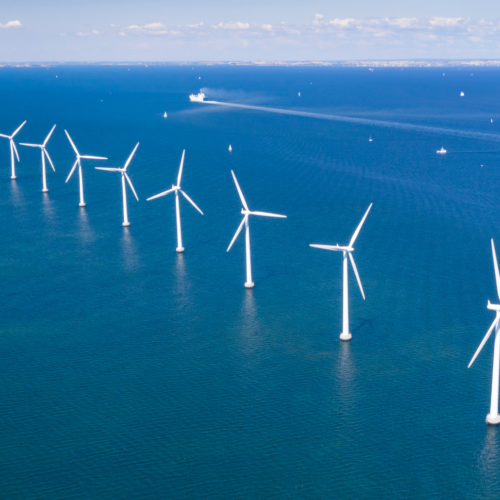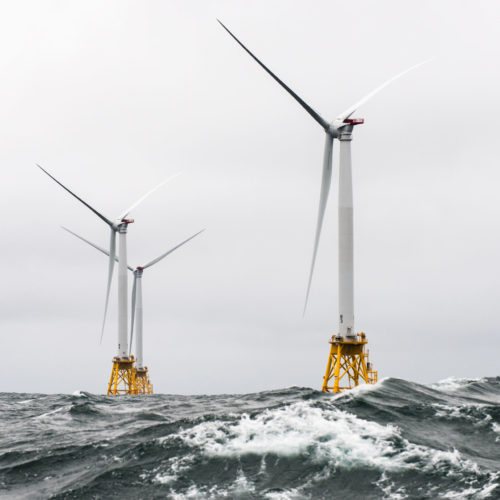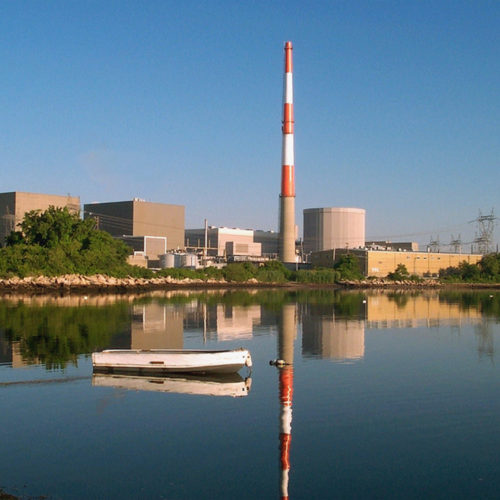Transmission, NIMBY, and the quest to decarbonize the grid
An earlier version of article appeared in the 2021-21 edition of Perspectives.

In early November, Maine voters approved a statewide ballot initiative to block further construction of the NECEC line. Avangrid CMP has filed a lawsuit claiming the referendum was unconstitutional. Credit: Isabel Beck.
In a swath of pristine forest in northwestern Maine, a heated conflict over a proposed transmission line has been playing out with striking familiarity.
The project, the New England Clean Energy Connect (NECEC), involves clear-cutting some 50 miles of Maine forest stretching southeast from the Canadian border to make way for transmission towers that would eventually connect with an existing utility corridor. The line would send Canadian hydropower to Massachusetts, where it would supply 17 percent of the electricity demand and help achieve the state’s ambitious climate mandates.
As with another proposal before it in neighboring New Hampshire, the NECEC set off a firestorm of local opposition from environmentalists and bipartisan officials, who warn the project would decimate critical habitat for brook trout, wintering deer, and other species, with little advantage to local communities. The developer, Avangrid Central Maine Power, says it will bring much-needed jobs.
Similar battles are being waged over transmission lines across the country — projects that are intended to transport clean energy to power-hungry regions, but end up sparking local opposition among residents and community leaders. These conflicts raise a fundamental question about the tradeoffs associated with transitioning to a clean-energy future: Are localized environmental disturbances justified to make way for large quantities of zero-emission power intended to lower a region’s overall carbon pollution?
“I think Maine and New Hampshire really have to be thoughtful for the precedents we’re setting. Are we going to be used as the source of more wealth extraction for others, or are we going to be lifted up and empowered as a result of the transition to clean energy?” said Maine state Representative Seth Berry, who joined members of the CSG East Energy and Environment Committee last August during a virtual discussion that explored strategies for achieving a low-carbon grid.
Maine and Massachusetts are among four northeastern states that have pledged — through statute or executive order — to reach net neutrality by 2050. And every New England state, with the exception of New Hampshire, has set targets to get at least 80 percent of its power from clean sources by 2050, if not earlier.
Those who favor building long-distance transmission to carry massive quantities of baseload hydropower claim that it’s cheaper than investing in huge amounts of distributed solar or other decentralized clean-energy generation. A 2020 report from Princeton University researchers found that transitioning to net-zero emissions by midcentury will require a 60 percent increase in high-voltage transmission in the next decade alone.
New research from the National Renewable Energy Laboratory (NREL) revealed that ramping up transmission to facilitate trade in zero-carbon energy across states and borders could lower overall electricity system costs and improve reliability in the United States and Canada.
“We see that there’s a lot of potential benefits to be had from transmission expansion and cooperation between regions,” said Greg Brinkman, model engineering researcher at NREL, who briefed the CSG East Energy and Environment Committee on the report during the August meeting.
A familiar conflict
Before the NECEC, residents in New Hampshire waged a nearly 10-year battle against the Northern Pass, a proposal that also would have sent Canadian hydropower south to Massachusetts — bypassing local customers — via towers up to 120 feet high winding through the White Mountains National Forest. The region is a key destination for tourism, the state’s second-largest industry.
During the August committee meeting, New Hampshire state Representative Suzanne Smith explained that she fought the Northern Pass proposal out of concern about its impacts to the environment, residents, and local businesses. Smith recounted how developers proposed to bury a portion of the line underneath Main Street in the town of Plymouth without consulting with town officials. It was a major undertaking that would have disrupted local businesses as well as Plymouth State University during the busiest months of the year, she said. “The town hosted a public hearing, attended by over 100 people. People were up in arms. It was going to tear up the entire downtown area,” said Smith.
Smith co-sponsored legislation that revamped the state’s Site Evaluation Committee, the final arbiter on the project, that required any new transmission projects to meet four key criteria in order to move forward. In 2018, the committee determined that the developer, Eversource, had not met one of those requirements: proving that the line would not unduly affect the orderly development of the region. In a unanimous vote, it denied the permit.
“It may have passed if they had communicated, listened to concerns, and found common ground with the communities and the people — rather than assuming they would be able to do it without working with the communities,” said Smith.
Weighing the benefits
Berry, who chairs the Maine Joint Standing Committee on Energy, Utilities and Technology, said he perceives a disconnect between the motives of investor-owned utilities like Avangrid Central Maine Power (CMP) and its parent company, Iberdrola, which are generally guaranteed a profit on new transmission projects, and environmentalists and local residents, who say those profits often come at the expense of the natural landscapes and local communities they run through.
Legislation that Berry sponsored earlier this year would have replaced Avangrid CMP and the state’s other private utility, Versant Power, with a consumer-owned utility that would answer to local residents and businesses instead of shareholders. Governor Janet Mills vetoed the bill in July, although it won bipartisan majorities in both the House and Senate. Supporters are planning to put the proposal before voters in a referendum next year.
In early November, voters approved a statewide ballot initiative to block further construction of the NECEC line. The law would take effect in early January. Meanwhile, Avangrid CMP has filed a lawsuit claiming the referendum was unconstitutional.
The project’s developers, for their part, have touted the benefits that it will offer the local economy. In a media release last January, Avangrid CMP said the project would create 1,600 well-paying jobs during construction and provide $200 million in upgrades to Maine’s energy grid, improving reliability.
“This is a huge economic stimulus — it means jobs and property taxes and a whole other package of benefits, but also cleaner air for Maine,” Thorn Dickinson, chief executive of NECEC Transmission LLC, the CMP-owned subsidiary that is building the line, told Energywire last August.
Berry said he isn’t necessarily opposed to building new transmission or using land to scale up renewables in Maine to help the state decarbonize. He said he hopes Maine can foster more jobs, through new renewable generation, than NECEC would create. But he emphasized that development needs to be compatible with farming, fishing, forestry, and other local industries that are dependent on the state’s natural resources, and needs to avoid exacerbating the climate effects of cutting down trees that sequester carbon. The current conflict might have been avoided had developers planned to build over existing rights-of-way instead of clear-cutting through remote forest, he added.

Maine state Representative Seth Berry. Credit: Susan Tuttle
If NECEC is ultimately halted, Massachusetts could still opt for a slightly more expensive alternative proposal to tie to the Québec grid, said Berry. The project, the New England Clean Power Link, is a fully permitted DC line that would be buried under Lake Champlain and under existing roads, and would not require cutting down trees. It would provide more than twice the financial benefits to the host state as what Maine and New Hampshire have been offered, he added.
“If we really do need to bring more power over high-voltage lines, let’s at least do it in a way that’s going to be more sensitive to the environmental impacts,” said Berry. “We can also be developing wind farms and solar farms and storage projects and offshore wind here and doing it in a thoughtful way and creating more jobs and value at home.”
Recently in New York, Governor Kathy Hochul announced two new transmission projects that aim to minimize local disruptions in delivering clean power to New York City. The lines would be buried under water bodies — including Lake Champlain and the Hudson River — and travel over existing rights-of-way for most of their routes.
Exploring collaborative approaches
At the federal level, the Biden administration has made clear that reforming transmission policy will be key to achieving its target of having all utilities generate their power from carbon-free resources by 2035.
In June, the Federal Energy Regulatory Commission (FERC) established a joint state-federal task force to encourage collaboration on new projects and to identify strategies for developing new transmission to meet state and federal policy goals.
Although the authority to regulate transmission line construction largely rests with the states, FERC is responsible for regulating interstate transmission of electricity and can provide financial incentives to energy companies to propose and build transmission lines.
One sector that is considered ripe for collaboration is offshore wind. Currently some 30 gigawatts are planned in federal waters up and down the East Coast by 2035 — enough energy to power 20 million homes — which could require an investment of up to $20 billion in new transmission, according to the Business Network for Offshore Wind, an industry group.
A report last year from the Brattle Group found that a planned transmission system off the coasts of New York and New England states serving multiple wind farms would reduce costs and lower impacts on fisheries and marine ecosystems.
Last year, New Jersey announced that it would pursue a novel pathway called a “state-agreement approach” to building transmission, and supporters hope it will serve as a model for transforming the way state clean energy priorities are incorporated into the transmission planning process. The approach allows the regional grid operator, PJM, to solicit transmission proposals on behalf of a state or group of states to partner and pay for a system that would meet public policy requirements. Rather than creating an individual grid infrastructure for each offshore wind farm, which is typical in Europe, state regulators are hoping to enable interconnections between offshore substations using “open access” transmission, sometimes called a transmission “backbone.”
In a press release, Joseph Fiordaliso, president of the New Jersey Board of Public Utilities, said the new approach “unlocks the potential for drastically minimizing community impacts, while saving money for New Jersey’s ratepayers.”
It’s an approach that aims to prevent the bitter local conflicts that have stymied past projects — conflicts that, experts agree, must be avoided if states are to have any hope of achieving their clean energy goals going forward.
In the coming year, the CSG East Energy and Environment Committee will continue to convene dialogues to assist officials with the monumental energy transition that is underway.





